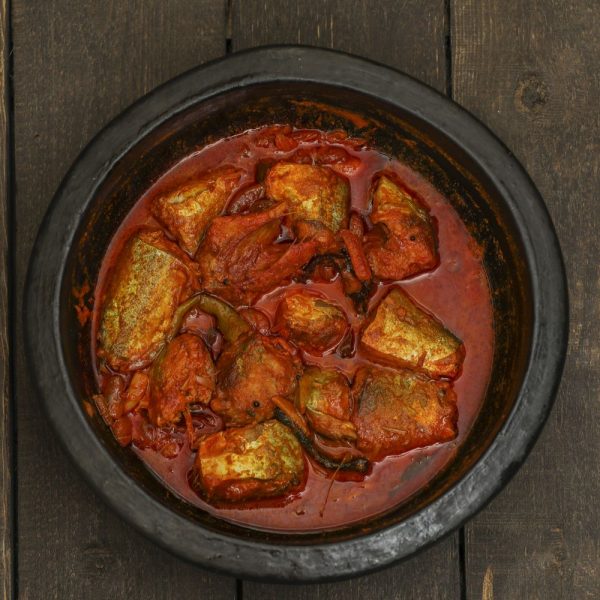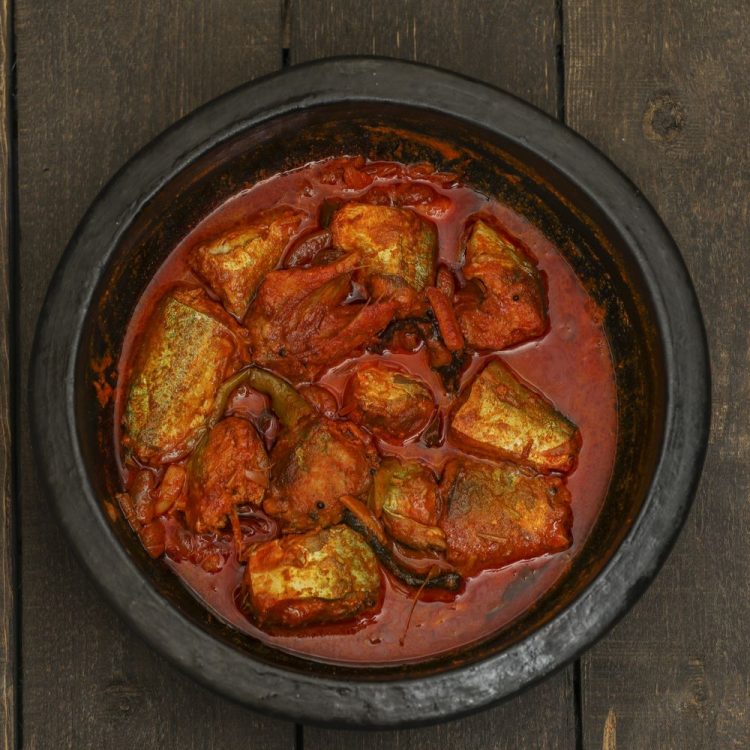Made with an interesting, key ingredient you may not know about!
If there’s one recipe that every Malayali mother knows like the back of her hand– it’s the simple, yet delicious Ayala curry, or Mackerel fish curry. Common in households across the state, this flavoursome curry is often paired with white rice or mashed tapioca (kappa). Tangy, spicy and quite easy to make, this ayala curry recipe is perfect for a quick meal for two. This recipe also uses an ingredient very common in Malyali kitchens but not elsewhere across the country–the kadampuli. Read on to find out out more about it!
If you’re looking for recipes for other Kerala-style dishes, check out our blog!
What is Ayala or Indian Mackerel?
And why it is the best choice for Ayala Curry.
Ayala or the Indian mackerel is a species of mackerel found all over India. Also known as bangada or kaanankeluthi, this fish is used in a variety of dishes (from curries to fried preparations) because of how quickly the fish cooks and how easily available and inexpensive it is. At Licious, we offer them whole and cleaned and in curry cuts, so you don’t have to spend additional time cleaning and cutting while making this delicious ayala curry!
The fish has a very mild flavour which allows it to be used in/with spicy, flavour loaded gravies and marinades. It’s also rich in a variety of nutrients such as omega 3 fatty acids, protein, vitamin B12, vitamin A, zinc, copper, selenium, potassium, phosphorous, iron, magnesium etc. Quite a lot of nutrients for a medium-sized fish!
The advantage of using ayala in this recipe is that you don’t need to marinate the fish beforehand. Since it cooks fast and absorbs the flavours of the gravy well, cooking it is one of the last steps in this recipe.
Okay, what’s kadampuli a.k.a Malabar Tamarind?
Kadampuli, much like regular tamarind, is used as a souring agent in most of the curries in Kerala. It’s used in Karnataka as well, where it is known as uppage. Most recipes use the fruit’s extract or its rind to provide the tartness to the dish (in this recipe we’ll be using its rind). It is also used in Assam as well as in Thailand, Malaysia, Burma and other Southeast Asian countries. It’s got a distinctive sweet-sour flavour that makes it different from regular tamarind.
It is known for its weight loss properties, decreasing insulin levels, controlling blood sugar and boosting the digestive process. Overall, it is a welcome addition to any gravy based preparation!
You can order kadampuli online or if you’re unable to do so, this recipe allows you to substitute it with regular tamarind.
A dish as yummy as this can’t not be shared on your social media, so, do post, tag us and use #MadewithLicious for a chance to get featured on our page!

| Prep Time | 1 hour |
| Servings |
people
|
- 500 g of Indian Mackerel steak cuts preferred
- 2-3 in pieces Kudampuli/ 1 lime sized Tamarind soakedwarm water
- 2 Tomatoes chopped
- 10-15 small onions chopped
- 3 green chillies sliced
- 1 tbsp red chilli powder
- 2 tbsp of Kashmiri Chilli Powder
- 1 tsp Black pepper powder
- 1/4 tbsp fenugreek powder
- 1/2 tbsp of turmeric powder
- 1 tsp Mustard Seeds
- 2 Sprigs Curry Leaves
- 2 tbsp ginger garlic paste
- 3 tbsp Coconut Oil
- Salt - to taste
- 2-3 glasses of water according to the consistency you would like
Ingredients
|
   |
- Heat coconut oil in a kadhai or in a clay pot (a.k.a manchatti)
- Add mustard seeds and let them splutter for a few seconds before adding your curry leaves
- Add your shallots, green chillies and ginger-garlic paste and fry until fragrant and the shallots turn translucent
- Add the tomatoes and saute until mushy; mash it with a spoon if required
- Meanwhile, mix the turmeric, fenugreek, red chilli and Kashmiri chilli powders together in another bowl. Add a few drops of water to make a thick paste
- Add this mixture to the pan and fry until cooked (for 2-3 mins)
- Add a few glasses of water until it reaches your desired consistency and bring to a boil. Add salt.
- Add the kadampuli or piece of tamarind and let the mixture boil for 5-8 minutes until the flavours become prominent in the gravy
- Add your pieces of ayala and reduce the flame to medium. Let it cook for another 5-8 minutes, covered.
- Optional: you can pan fry some slices of small onions to top off the curry
- Remove from the heat and serve with rice

